Making Wider Use of the Japanese-Language Section at the Mongolia-Japan Center for Human Resources Development as a Place to Experience “the Japanese Language” and “Japanese Culture”
Mongolia-Japan Center for Human Resources Development
SAITO Satoko
The Japanese-language section at the Mongolia-Japan Center for Human Resources Development (hereinafter the “Center”) holds six courses of the “Marugoto: Japanese Language and Culture” JF Japanese-language course (hereinafter “Marugoto” course”), a general Japanese-language course, in spring and autumn. Students taking classes in General Course 1 (“Marugoto Starter,” a 20-session course), which involves only 40 hours of study, undertook a group activity in which they compiled things they were able to say and express on their own, centering on things they had learned in the textbook, on imitation Japanese vellum. The theme of the group activity on this day was “My family,” which is covered in the “Marugoto” course. Each group was made up of five or six people, and during the presentations each of the group’s members performed the role of a family member. Many of the participants said the activity was “enjoyable” or “difficult but interesting,” and their faces beamed with satisfaction. The people taking the class are from a mix of age groups, from their teens through to their 40s, but it could be said that this fun atmosphere is a notable feature of the Center’s courses, with students and working adults carrying out activities and learning alongside one another.
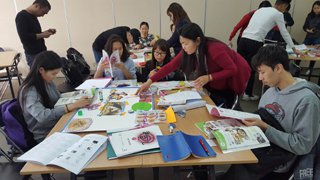
Groups working on making their posters
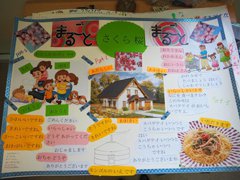
Poster-making: “My family”
In addition, up to now we had been holding an orientation on kanji study for each class, but from last year we decided to assemble participants in the lobby 30 minutes prior to classes starting, in order to do it all at once. The things we want the participants to remember about kanji, from the way they are composed through to the radicals, are introduced in an easy-to-understand manner. This also has the effect of creating a sense of togetherness that goes beyond the lines of the courses.
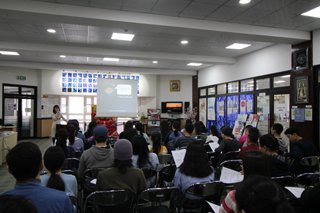
The kanji orientation in the Center’s lobby
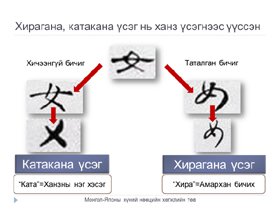
A slide from the kanji orientation
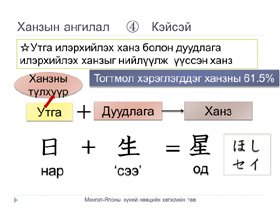
A slide from the kanji orientation
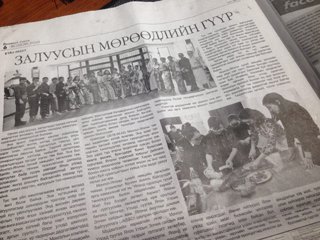
Introduced in the Ugluunii Sonin newspaper
On April 4, the Ugluunii Sonin newspaper (Ugluunii means “morning” in Mongolian) published an article titled “A bridge for young people’s dreams.” The photos accompanying the article show scenes from a cultural experience class. Dressing up in Yukata (Japanese summer kimono) to dance the Bon Festival dance was very well received. In one photo the women are shown in the “Mikaeri Bijin (Beauty Looking Back)” style having their Obi (belts) tied, and the lower photo shows students trying out Japanese cooking by taking on the challenge of “hot pot cooking.” The newspaper is widely read in Ulaanbaatar City, and being featured in the paper undoubtedly boosted the students’ desire to study the Japanese language all the more.
The following photo was taken during an instructional traveling tour to Humuun Complex School in the central province city of Zuunmod. I talked to students interested in the Japanese language about using The Japan Foundation’s website to study. The goal was to make “Erin's Challenge! I Can Speak Japanese” and “JF Japanese e-learning Minato” useful for their autonomous learning and encourage them to enjoy learning Japanese. Because most students own smartphones, the environment is conducive to them utilizing apps. Going forward also, I want to make Japanese-language learning available to more learners living in regional areas, not just in Ulaanbaatar City in the center of Mongolia, via The Japan Foundation’s website and apps.
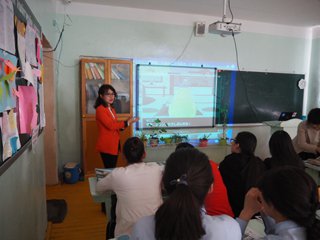
Showcasing the JF’s website during an instructional traveling tour. Download the apps!!!
In addition to the activities, I have outlined above, other cultural activities hosted by the Center’s library and information exchange section include interactive events in each season, Japanese film screenings and a “Japanese language club.” Across the Center as a whole there is a strong desire to promote Japanese culture and deepen exchanges with Mongolia. This year, 2018, is the 20th anniversary of the founding of the Mongolian Japanese Language Teachers Association, and with that in mind also, an even larger number of events aimed at making Japan more familiar are scheduled to be held in the future.
With regard to Japanese lessons, the following impressions were included in the Center’s annual report, which was published in May. “I believe there are more than a few students who like watching Anime, and I am one of them. I like Japanese etiquette and culture, and that is why I began studying Japanese. When it first occurred to me to try and study Japanese, I was very fortunate to discover the Japanese-language courses at the Mongolia-Japan Center for Human Resources Development. Since I began taking classes, I have come to realize that the themes, content and other aspects of the lessons are all being implemented according to a proper plan, and I have been able to secure a basic knowledge of the Japanese language quite effectively, I believe.” This is an excerpt from a composition by a student who is taking General Course 5. I think teachers who read comments like this from their students will be encouraged and will be able to persevere. On a day-to-day basis efforts are made to run the courses according to plan, including by holding “teaching plan review meetings” for each course to share information and discuss any problem areas with classes, and by carefully recording problem areas in journals to pass them on. I think the students taking the courses can sense these efforts.
Since being dispatched to Mongolia, one of my challenges has been increasing the ratio of course participants who continue on to the next course. The staff and I thought about what we could do to reduce the drop-out rate and create a sense of unity in the classes, and then put our ideas into practice. We contacted absentees by phone, interacted with them on the class/course Facebook group pages, found students taking the classes who would oversee handouts or oversee homework, and increased the number of opportunities for students taking the classes to come into contact with one another. Thanks to initiatives such as creating registers of the people taking the classes that include photos of their faces, and making it easier to share student information between teachers performing team teaching, the ratio of students who continue on to the next course is gradually increasing. For the teachers also, being aware of this challenge has presented a good opportunity to think about how they run their classes, I believe.
- What We Do Top
- Arts and Cultural Exchange [Culture]
- Japanese-Language Education Overseas [Language]
- Japanese-Language Education Overseas [Language] Top
- Learn Japanese-language
- Teach Japanese-language
- Take Japanese-Language Test
- Know about Japanese-language education abroad
- The Japanese-Language Institute, Urawa
- The Japanese-Language Institute, Kansai
- Japanese-Language Programs for Foreign Specified Skilled Worker Candidates
- Japanese Language Education for Japanese Children Resident Overseas and for the Descendants of Migrants
- Archives
- Japanese Studies and Global Partnerships [Dialogue]
- JF digital collection
- Other Programs / Programs to Commemorate Exchange Year
- Awards and Prizes
- Publications
